sensor KIA Carens 2017 3.G Owner's Guide
[x] Cancel search | Manufacturer: KIA, Model Year: 2017, Model line: Carens, Model: KIA Carens 2017 3.GPages: 625, PDF Size: 19.69 MB
Page 444 of 625
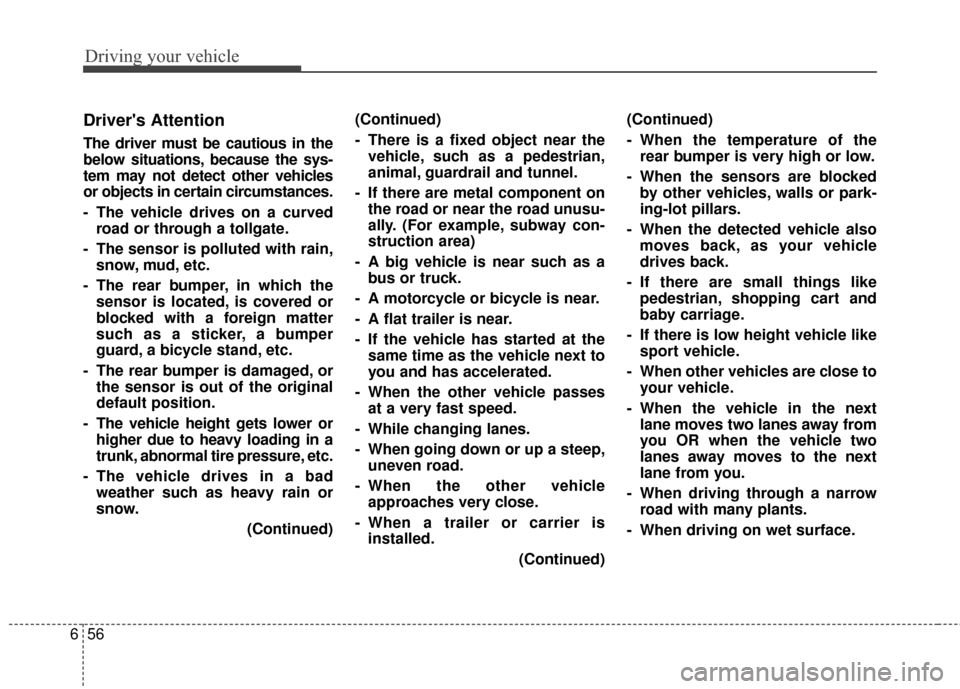
Driving your vehicle
56
6
Driver's Attention
The driver must be cautious in the
below situations, because the sys-
tem may not detect other vehicles
or objects in certain circumstances.
- The vehicle drives on a curved
road or through a tollgate.
- The sensor is polluted with rain, snow, mud, etc.
- The rear bumper, in which the sensor is located, is covered or
blocked with a foreign matter
such as a sticker, a bumper
guard, a bicycle stand, etc.
- The rear bumper is damaged, or the sensor is out of the original
default position.
- The vehicle height gets lower or higher due to heavy loading in a
trunk, abnormal tire pressure, etc.
- The vehicle drives in a bad weather such as heavy rain or
snow.
(Continued)(Continued)
- There is a fixed object near the
vehicle, such as a pedestrian,
animal, guardrail and tunnel.
- If there are metal component on the road or near the road unusu-
ally. (For example, subway con-
struction area)
- A big vehicle is near such as a bus or truck.
- A motorcycle or bicycle is near.
- A flat trailer is near.
- If the vehicle has started at the same time as the vehicle next to
you and has accelerated.
- When the other vehicle passes at a very fast speed.
- While changing lanes.
- When going down or up a steep, uneven road.
- When the other vehicle approaches very close.
- When a trailer or carrier is installed.
(Continued)(Continued)
- When the temperature of the
rear bumper is very high or low.
- When the sensors are blocked by other vehicles, walls or park-
ing-lot pillars.
- When the detected vehicle also moves back, as your vehicle
drives back.
- If there are small things like pedestrian, shopping cart and
baby carriage.
- If there is low height vehicle like sport vehicle.
- When other vehicles are close to your vehicle.
- When the vehicle in the next lane moves two lanes away from
you OR when the vehicle two
lanes away moves to the next
lane from you.
- When driving through a narrow road with many plants.
- When driving on wet surface.
Page 482 of 625
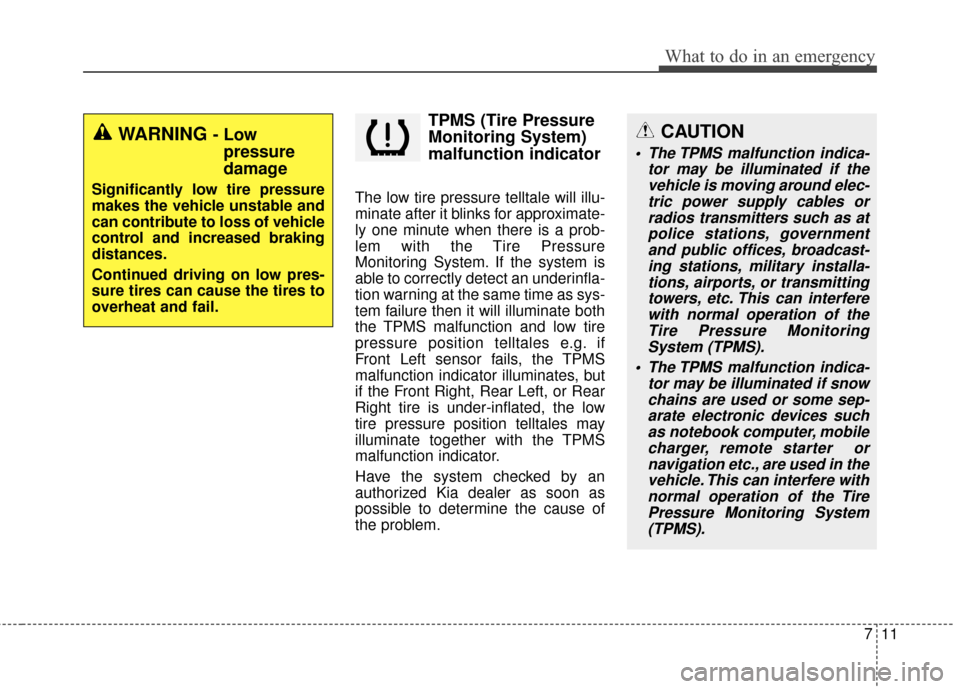
711
What to do in an emergency
TPMS (Tire Pressure
Monitoring System)
malfunction indicator
The low tire pressure telltale will illu-
minate after it blinks for approximate-
ly one minute when there is a prob-
lem with the Tire Pressure
Monitoring System. If the system is
able to correctly detect an underinfla-
tion warning at the same time as sys-
tem failure then it will illuminate both
the TPMS malfunction and low tire
pressure position telltales e.g. if
Front Left sensor fails, the TPMS
malfunction indicator illuminates, but
if the Front Right, Rear Left, or Rear
Right tire is under-inflated, the low
tire pressure position telltales may
illuminate together with the TPMS
malfunction indicator.
Have the system checked by an
authorized Kia dealer as soon as
possible to determine the cause of
the problem.
WARNING - Low pressure
damage
Significantly low tire pressure
makes the vehicle unstable and
can contribute to loss of vehicle
control and increased braking
distances.
Continued driving on low pres-
sure tires can cause the tires to
overheat and fail.
CAUTION
The TPMS malfunction indica-
tor may be illuminated if thevehicle is moving around elec-tric power supply cables orradios transmitters such as atpolice stations, governmentand public offices, broadcast-ing stations, military installa-tions, airports, or transmittingtowers, etc. This can interferewith normal operation of theTire Pressure MonitoringSystem (TPMS).
The TPMS malfunction indica- tor may be illuminated if snowchains are used or some sep-arate electronic devices suchas notebook computer, mobilecharger, remote starter ornavigation etc., are used in thevehicle. This can interfere withnormal operation of the TirePressure Monitoring System(TPMS).
Page 483 of 625
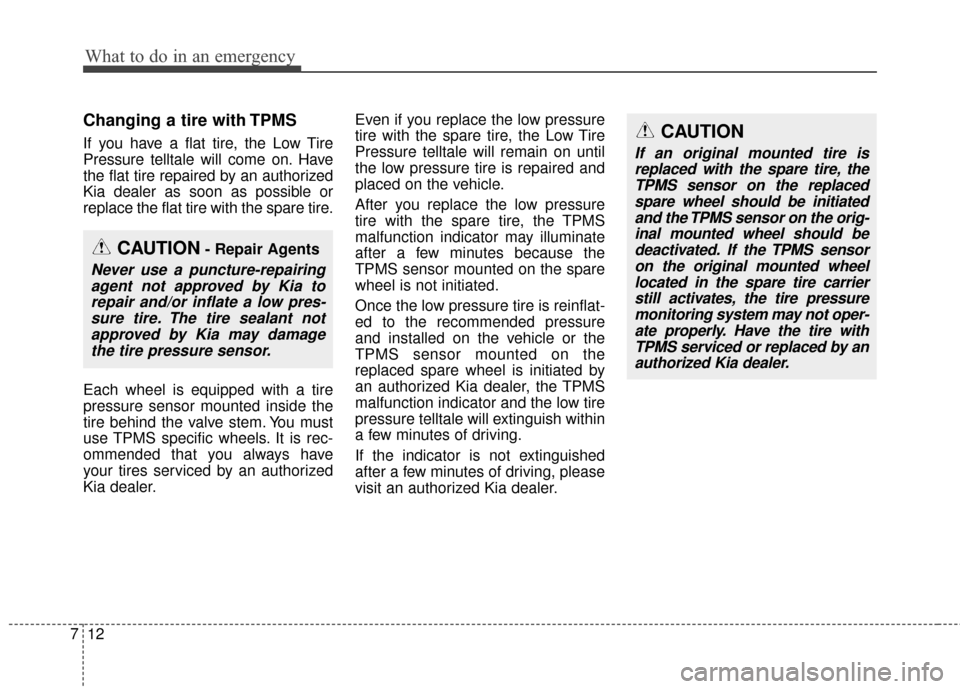
What to do in an emergency
12
7
Changing a tire with TPMS
If you have a flat tire, the Low Tire
Pressure telltale will come on. Have
the flat tire repaired by an authorized
Kia dealer as soon as possible or
replace the flat tire with the spare tire.
Each wheel is equipped with a tire
pressure sensor mounted inside the
tire behind the valve stem. You must
use TPMS specific wheels. It is rec-
ommended that you always have
your tires serviced by an authorized
Kia dealer. Even if you replace the low pressure
tire with the spare tire, the Low Tire
Pressure telltale will remain on until
the low pressure tire is repaired and
placed on the vehicle.
After you replace the low pressure
tire with the spare tire, the TPMS
malfunction indicator may illuminate
after a few minutes because the
TPMS sensor mounted on the spare
wheel is not initiated.
Once the low pressure tire is reinflat-
ed to the recommended pressure
and installed on the vehicle or the
TPMS sensor mounted on the
replaced spare wheel is initiated by
an authorized Kia dealer, the TPMS
malfunction indicator and the low tire
pressure telltale will extinguish within
a few minutes of driving.
If the indicator is not extinguished
after a few minutes of driving, please
visit an authorized Kia dealer.CAUTION
If an original mounted tire is
replaced with the spare tire, theTPMS sensor on the replacedspare wheel should be initiatedand the TPMS sensor on the orig-inal mounted wheel should bedeactivated. If the TPMS sensoron the original mounted wheellocated in the spare tire carrierstill activates, the tire pressuremonitoring system may not oper-ate properly. Have the tire withTPMS serviced or replaced by anauthorized Kia dealer.
CAUTION- Repair Agents
Never use a puncture-repairingagent not approved by Kia torepair and/or inflate a low pres-sure tire. The tire sealant notapproved by Kia may damagethe tire pressure sensor.
Page 484 of 625
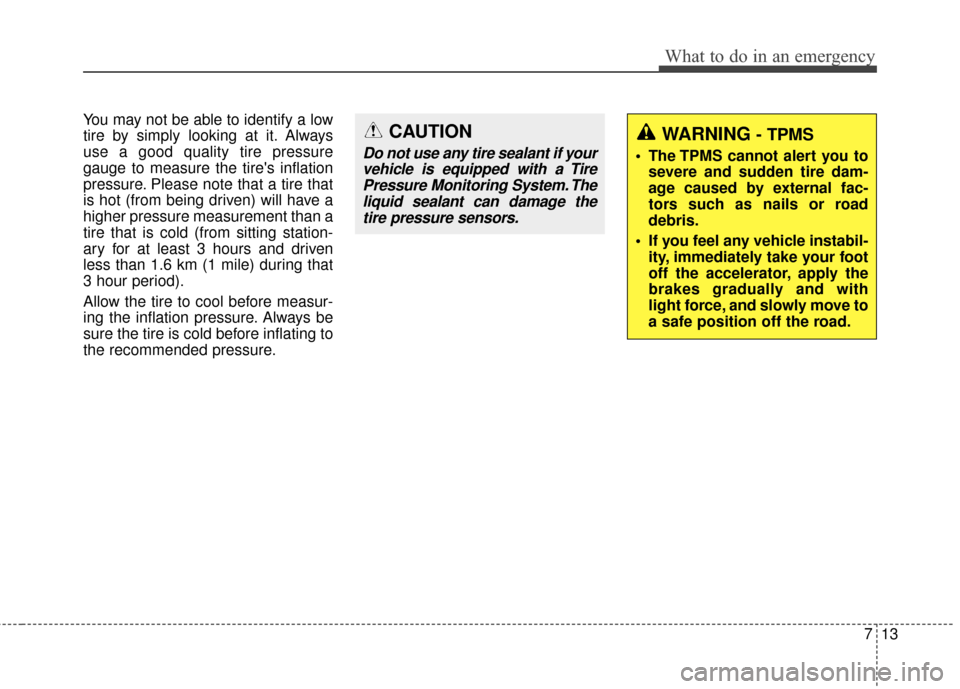
713
What to do in an emergency
You may not be able to identify a low
tire by simply looking at it. Always
use a good quality tire pressure
gauge to measure the tire's inflation
pressure. Please note that a tire that
is hot (from being driven) will have a
higher pressure measurement than a
tire that is cold (from sitting station-
ary for at least 3 hours and driven
less than 1.6 km (1 mile) during that
3 hour period).
Allow the tire to cool before measur-
ing the inflation pressure. Always be
sure the tire is cold before inflating to
the recommended pressure.CAUTION
Do not use any tire sealant if yourvehicle is equipped with a TirePressure Monitoring System. Theliquid sealant can damage thetire pressure sensors.
WARNING- TPMS
The TPMS cannot alert you to severe and sudden tire dam-
age caused by external fac-
tors such as nails or road
debris.
If you feel any vehicle instabil- ity, immediately take your foot
off the accelerator, apply the
brakes gradually and with
light force, and slowly move to
a safe position off the road.
Page 574 of 625
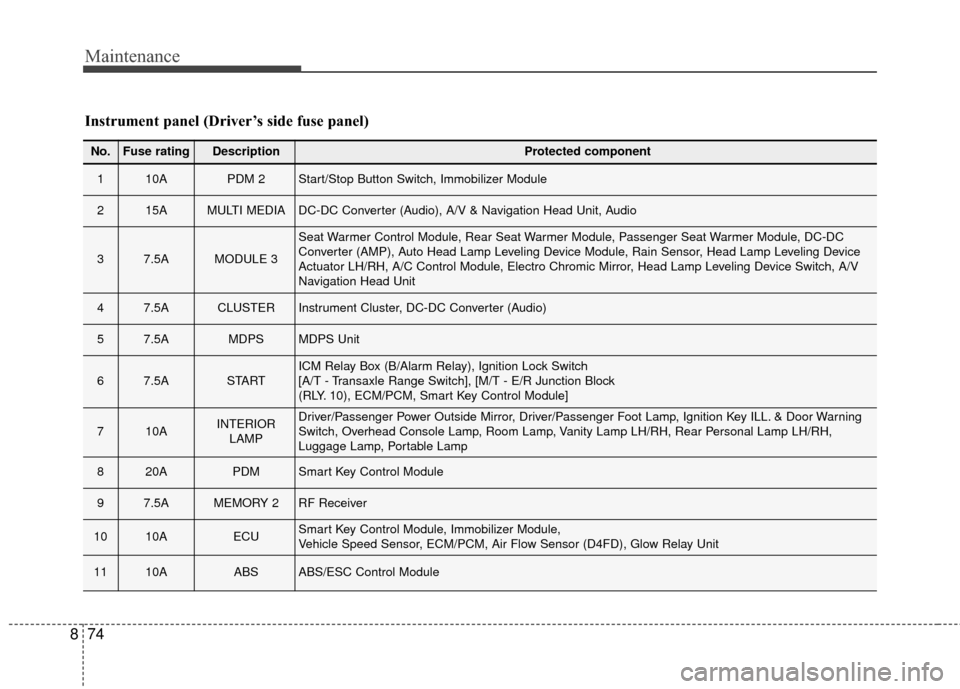
Maintenance
74
8
Instrument panel (Driver’s side fuse panel)
No.Fuse ratingDescriptionProtected component
110APDM 2Start/Stop Button Switch, Immobilizer Module
215AMULTI MEDIADC-DC Converter (Audio), A/V & Navigation Head Unit, Audio
37.5AMODULE 3
Seat Warmer Control Module, Rear Seat Warmer Module, Passenger Seat Warmer Module, DC-DC
Converter (AMP), Auto Head Lamp Leveling Device Module, Rain Sensor, Head Lamp Leveling Device
Actuator LH/RH, A/C Control Module, Electro Chromic Mirror, Head Lamp Leveling Device Switch, A/V
Navigation Head Unit
47.5ACLUSTERInstrument Cluster, DC-DC Converter (Audio)
57.5AMDPSMDPS Unit
67.5ASTARTICM Relay Box (B/Alarm Relay), Ignition Lock Switch
[A/T - Transaxle Range Switch], [M/T - E/R Junction Block
(RLY. 10), ECM/PCM, Smart Key Control Module]
710AINTERIOR
LAMPDriver/Passenger Power Outside Mirror, Driver/Passenger Foot Lamp, Ignition Key ILL. & Door Warning
Switch, Overhead Console Lamp, Room Lamp, Vanity Lamp LH/RH, Rear Personal Lamp LH/RH,
Luggage Lamp, Portable Lamp
820APDMSmart Key Control Module
97.5AMEMORY 2RF Receiver
1010AECUSmart Key Control Module, Immobilizer Module,
Vehicle Speed Sensor, ECM/PCM, Air Flow Sensor (D4FD), Glow Relay Unit
1110AABSABS/ESC Control Module
Page 575 of 625
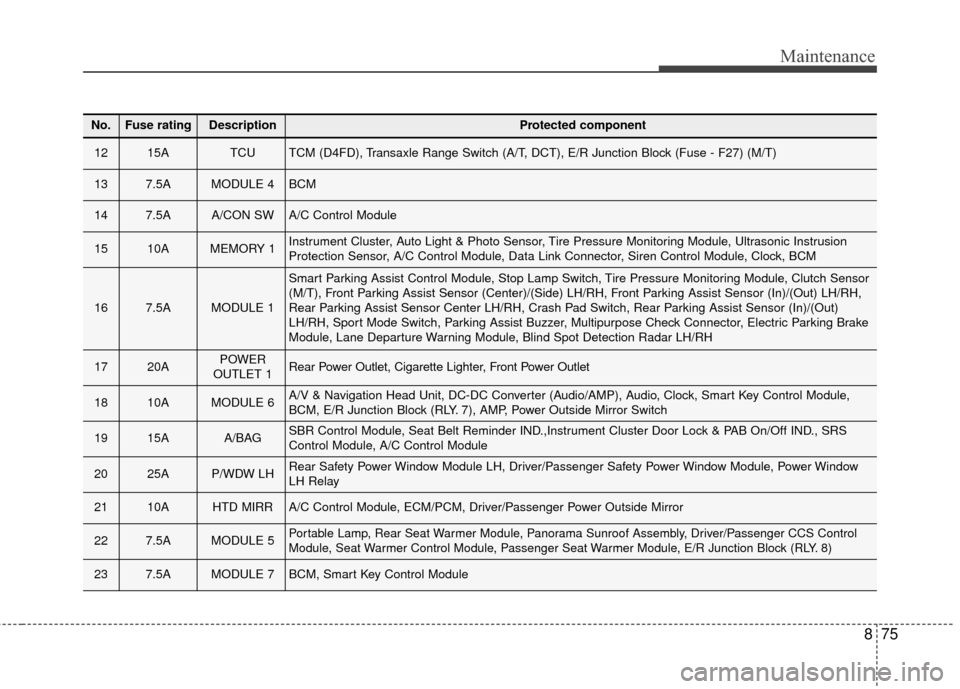
875
Maintenance
No.Fuse ratingDescriptionProtected component
1215ATCUTCM (D4FD), Transaxle Range Switch (A/T, DCT), E/R Junction Block (Fuse - F27) (M/T)
137.5AMODULE 4BCM
147.5AA/CON SWA/C Control Module
1510AMEMORY 1Instrument Cluster, Auto Light & Photo Sensor, Tire Pressure Monitoring Module, Ultrasonic Instrusion
Protection Sensor, A/C Control Module, Data Link Connector, Siren Control Module, Clock, BCM
167.5AMODULE 1
Smart Parking Assist Control Module, Stop Lamp Switch, Tire Pressure Monitoring Module, Clutch Sensor
(M/T), Front Parking Assist Sensor (Center)/(Side) LH/RH, Front Parking Assist Sensor (In)/(Out) LH/RH,
Rear Parking Assist Sensor Center LH/RH, Crash Pad Switch, Rear Parking Assist Sensor (In)/(Out)
LH/RH, Sport Mode Switch, Parking Assist Buzzer, Multipurpose Check Connector, Electric Parking Brake
Module, Lane Departure Warning Module, Blind Spot Detection Radar LH/RH
1720APOWER
OUTLET 1Rear Power Outlet, Cigarette Lighter, Front Power Outlet
1810AMODULE 6A/V & Navigation Head Unit, DC-DC Converter (Audio/AMP), Audio, Clock, Smart Key Control Module,
BCM, E/R Junction Block (RLY. 7), AMP, Power Outside Mirror Switch
1915AA/BAGSBR Control Module, Seat Belt Reminder IND.,Instrument Cluster Door Lock & PAB On/Off IND., SRS
Control Module, A/C Control Module
2025AP/WDW LHRear Safety Power Window Module LH, Driver/Passenger Safety Power Window Module, Power Window
LH Relay
2110AHTD MIRRA/C Control Module, ECM/PCM, Driver/Passenger Power Outside Mirror
227.5AMODULE 5Portable Lamp, Rear Seat Warmer Module, Panorama Sunroof Assembly, Driver/Passenger CCS Control
Module, Seat Warmer Control Module, Passenger Seat Warmer Module, E/R Junction Block (RLY. 8)
237.5AMODULE 7BCM, Smart Key Control Module
Page 579 of 625
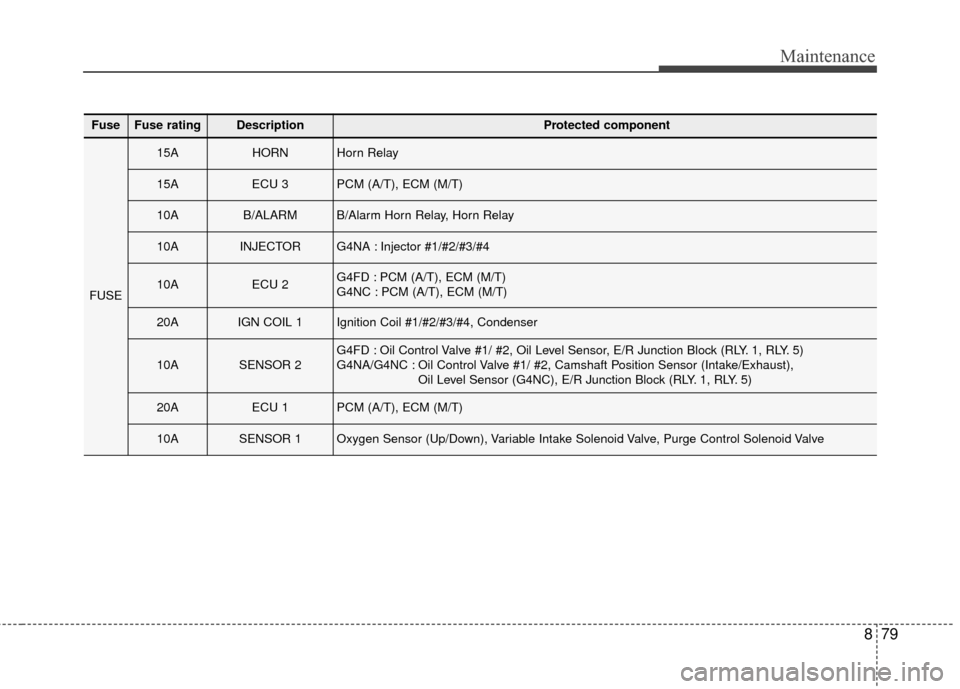
879
Maintenance
FuseFuse ratingDescriptionProtected component
FUSE
15AHORNHorn Relay
15AECU 3PCM (A/T), ECM (M/T)
10AB/ALARMB/Alarm Horn Relay, Horn Relay
10AINJECTORG4NA : Injector #1/#2/#3/#4
10AECU 2G4FD : PCM (A/T), ECM (M/T)
G4NC : PCM (A/T), ECM (M/T)
20AIGN COIL 1Ignition Coil #1/#2/#3/#4, Condenser
10ASENSOR 2G4FD : Oil Control Valve #1/ #2, Oil Level Sensor, E/R Junction Block (RLY. 1, RLY. 5)
G4NA/G4NC : Oil Control Valve #1/ #2, Camshaft Position Sensor (Intake/Exhaust),Oil Level Sensor (G4NC), E/R Junction Block (RLY. 1, RLY. 5)
20AECU 1PCM (A/T), ECM (M/T)
10ASENSOR 1Oxygen Sensor (Up/Down), Variable Intake Solenoid Valve, Purge Control Solenoid Valve
Page 593 of 625
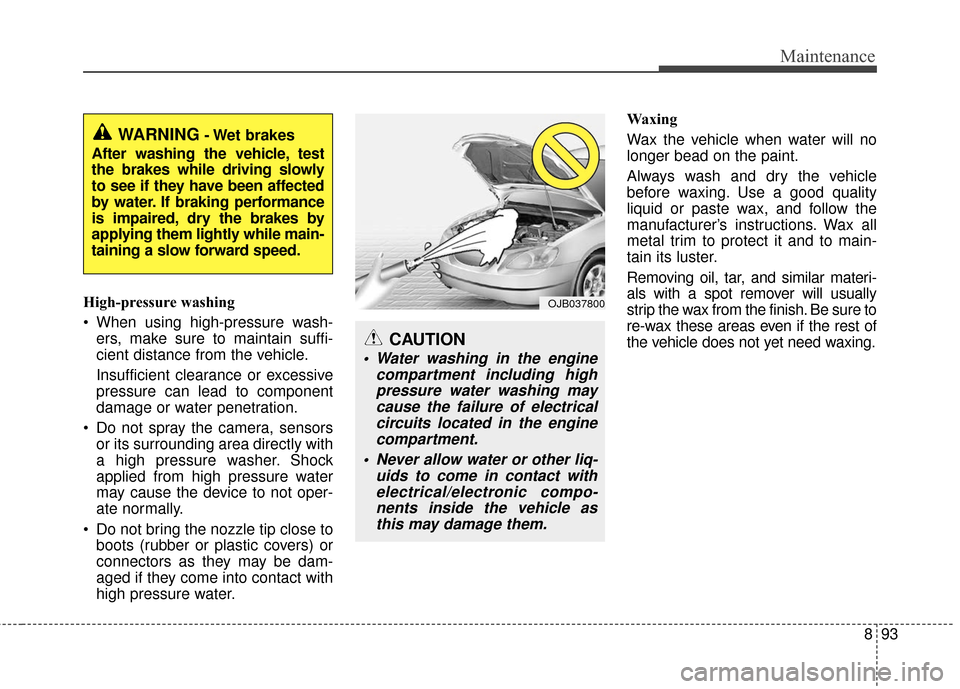
893
Maintenance
High-pressure washing
When using high-pressure wash-ers, make sure to maintain suffi-
cient distance from the vehicle.
Insufficient clearance or excessive
pressure can lead to component
damage or water penetration.
Do not spray the camera, sensors or its surrounding area directly with
a high pressure washer. Shock
applied from high pressure water
may cause the device to not oper-
ate normally.
Do not bring the nozzle tip close to boots (rubber or plastic covers) or
connectors as they may be dam-
aged if they come into contact with
high pressure water. Waxing
Wax the vehicle when water will no
longer bead on the paint.
Always wash and dry the vehicle
before waxing. Use a good quality
liquid or paste wax, and follow the
manufacturer’s instructions. Wax all
metal trim to protect it and to main-
tain its luster.
Removing oil, tar, and similar materi-
als with a spot remover will usually
strip the wax from the finish. Be sure to
re-wax these areas even if the rest of
the vehicle does not yet need waxing.
CAUTION
Water washing in the engine
compartment including highpressure water washing maycause the failure of electricalcircuits located in the enginecompartment.
Never allow water or other liq- uids to come in contact withelectrical/electronic compo-nents inside the vehicle asthis may damage them.
OJB037800
WARNING- Wet brakes
After washing the vehicle, test
the brakes while driving slowly
to see if they have been affected
by water. If braking performance
is impaired, dry the brakes by
applying them lightly while main-
taining a slow forward speed.